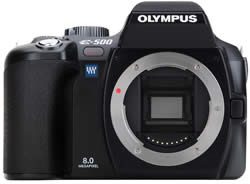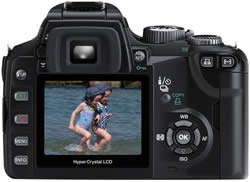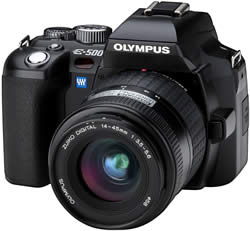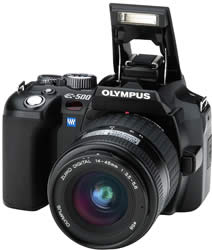Olympus E-500 Digital SLR Announced
 The Olympus E-500 digital SLR camera is announced today. The Olympus E500 is an 8 megapixel DSLR with a 2.5 inch LCD screen in a body with a classic penta-prism design. A unique Supersonic Wave Filter eliminates dust problems and the E-500 also offers improved metering from a 49 area sensor. The Olympus E-500 will be available at the end of October, with the standard kit costing around £600 and the double zoom lens kit costing around £650.
The Olympus E-500 digital SLR camera is announced today. The Olympus E500 is an 8 megapixel DSLR with a 2.5 inch LCD screen in a body with a classic penta-prism design. A unique Supersonic Wave Filter eliminates dust problems and the E-500 also offers improved metering from a 49 area sensor. The Olympus E-500 will be available at the end of October, with the standard kit costing around £600 and the double zoom lens kit costing around £650.
Olympus UK Press Release
Classic design with a futuristic edge - Olympus announce the E-500
London, 26 September 2005, Digital SLR photography is gaining in popularity as more and more people become hooked on the higher quality and flexibility that only an SLR camera can offer. Olympus today announces the E-500 - its impressive new addition to the E-System SLR range.The Olympus E-500 will be available by the end of October.
Delivering the versatility and power that are the hallmarks of a performance SLR the E-500’s impressive range of features include:
· A compact, lightweight and easy to handle body in a classic penta-prism design
· A professionally approved, user-friendly controls layout
· An 8 megapixel Full Frame Transfer CCD
· Olympus’ unique Supersonic Wave Filter to eliminate problems with dust when changing lenses
· A shot preview function to provide easy viewing of images before they are saved onto the memory card
· A high resolution 2½? HyperCrystal LCD with 215,250 pixels
· Improved metering from a 49 area sensor
· A special filter to minimise image noise at high ISO levels
· Two memory card slots for Compact Flash and xD media cards
· Full manual control or a choice of 21 pre-defined scene modes
 Available to buy alone, or as part of a range of kits, The E-500 will suit every photographers needs. Full pricing to be confirmed in October:
Available to buy alone, or as part of a range of kits, The E-500 will suit every photographers needs. Full pricing to be confirmed in October:
· BODY KIT includes E-500 body, BLM-1 rechargeable battery pack with BCM-2 charger
· SE KIT includes E-500 body, 17.5-45mm (35-90mm) 1:3.5-5.6, LBH-1 battery holder, 3x CR-123 batteries
· STANDARD KIT includes E-500 body, 14-45mm (28-90mm) 1:3.5-5.6, BLM-1 rechargeable battery pack with BCM-2 charger estimated price around £600
· DOUBLE ZOOM KIT includes E-500 body, 14-45mm (28-90mm) 1:3.5-5.6, 40-150mm (80-300mm) 1:3.5-4.5, BLM-1 rechargeable battery pack with BCM-2 charger estimated price around £650
Classic Design
The Olympus E-500 has been designed with the user in mind. This means menus that make sense and buttons on the body that are easy to understand and operate, adding automatic settings for every imaginable situation and making the LCD big and bright enough so users can easily review all their shots.
A traditional penta-prism shape gives the camera an authentic and professional look and feel, the user-friendly controls and functions are easy to operate and the handgrip has been positioned so that the camera can easily be kept stable when shooting. The E-500 is ideal for numerous photographic situations, from capturing landscape vistas whilst mountaineering to documenting a city’s hustle and bustle.
Direct Button operation enables E-500 users to get to the settings they want without wading through endless menus or pushing arrow buttons excessively. Instead, most custom settings can be set by pressing one of the cameras eight direct key buttons for White Balance, Exposure Compensation, ISO, Flash Mode, Metering Mode, Auto Focus Mode, Auto Focus Frame and Recording Mode, and then turning a dial by thumb to customise the setting as desired. All settings are viewable at once on the camera’s control panel displayed on the LCD.
 Skills Development
Skills Development
The E-500 includes 21 pre-defined scene modes, ranging from landscape to sunset to portrait, meaning it can be picked up and used straight away. However, as a photographer’s skills develop, the manual controls come into their own, enabling experimentation only limited by the photographer’s imagination. P/A/S/M modes come as standard.
To radically improve the metering capability a new 49 area AE sensor providing accurate exposure values for ESP metering is included. This uses a newly-developed evaluation algorithm. Conventional centre-weighted average and spot metering, high light and shadow basis spot metering and AE Lock functioning are also available too making the E-500 the ideal choice for any ambitious amateur or creative semi-pro wishing to develop their individual technique and style over time.
Image Quality
The E-500 provides outstanding image quality. An eight megapixel, Full Frame Transfer CCD offers a larger pixel area than an ordinary Interline Transfer CCD and as a result delivers images with a greater exposure latitude, more detail and less noise.
Dust is all around us and when swapping a lens on a digital single-lens reflex camera there’s a chance that a camera’s electro-statically charged image sensor will attract micro dust that can ruin photos. Olympus has developed a way for photographers to enjoy the freedom of using all the lenses of the Olympus E-System in the most challenging, dusty environments without compromising image quality. Every time the camera is turned on Olympus’ Supersonic Wave Filter, a patented ultrasonic technology that shakes at 35,000 vibrations a second to remove dust from in front of the camera sensor is activated. The spot-free photos that are produced liberate users from hours spent retouching photographs at the computer.
The camera is also equipped with a noise filter that can be turned on and off, as the photographer desires to minimise image noise at high ISO values.
 Powerful Processor
Powerful Processor
The E-500 incorporates Olympus’ TruePic TURBO image processor to ensure images pack a punch with lifelike colour, resolution and contrast. TruePic TURBO also adds speed to picture taking. For fast burst rates, the processor uses the dedicated 64MB image buffer for up to 4 TIFF or RAW images at 2.5 frames-per-second. However, when using HQ JPEG images and extreme speed Compact Flash cards the number of frames a user is able to take is only lmited by the card size. For example, when using a SanDisk Extreme III CF card the camera can take around 4 minutes of continuous photography at 2 frames per second !
To further enhance the camera’s capabilities, two memory card slots, one for a CompactFlash and another for an xD memory card, are included.
Viewing The Results
Results can be viewed on the E-500’s 2½ inch, 215,250 pixel HyperCrystal LCD screen that offers many times the contrast of conventional LCD monitors. Views of recorded shots can be enlarged up to 14x to facilitate easy reviewing and the LCD also doubles as the camera’s easy-to-read status panel, giving clear and detailed information of the current settings in use.
Four Thirds
As the only completely digital system, based on the TIPA Award winning Four Thirds Standard, the Olympus E-System series of camera bodies, interchangeable lenses, external flash systems and other accessories provides professionals and serious amateurs alike with the excellence they demand. The new Olympus E-500 offers an affordable entry into the exciting world of SLR photography.
E-500 Further Explanation…
Because the E-500 is designed for the ultimate user-friendly experience, you can choose to let the camera make all the decisions, or take control yourself. Below is some additional information on the manual controls that you may find useful:
5 Metering Modes
A new 49 Point Digital ESP Light Meter enables digital electro selective pattern metering for accurate exposures under the largest number of conditions. The Digital ESP can also be linked to the AF (auto focus) selection or independent of the AF selection for even more versatility. Olympus’ widely acclaimed proprietary Digital ESP metering calculates the best light values under complex lighting conditions. Centre-weighted metering is biased to the centre of the viewfinder (cross) area. Spot Meter (2%) enables the most accurate metering for tough lighting conditions like backlit or spot lit. Highlight Spot Meter (2%) adjusts for predominantly white subject for correct exposure with detail. Shadow Spot Meter (2%) adjusts for a black subject, providing the correct exposure with detail.
3 Colour Modes: Vivid / Natural / Muted
Vivid mode produces photos with more highly saturated colours and higher contrast to optimize images when vivid shots are required. This is also the recommended setting when printing directly from the camera to an inkjet printer. The Natural mode produces realistic colour similar to those seen by the human eye and is the perfect choice for the discerning photographer looking for the most realistic photos. The Muted mode is ideal for those users who plan to heavily manipulate or edit their images with the included OLYMPUS Master Software or with Adobe® Photoshop™.
A Choice of Two Colour Space Settings
Users can choose from two colour space settings according to their needs: sRGB, which is the standard for computer monitor viewing and inkjet printer output, and Adobe® RGB, which is widely used for commercial applications.
9 Black & White Modes
Red, Yellow, Orange, and Green filters can be selected to replicate the same traditional film filters, enhancing the drama of the image in the Black & White shooting mode. In addition to Sepia tone, the E-500 also offers users three tone effects: Blue, Green and Purple for special results.
2 Red-Eye Reduction modes, on Flash and in Playback
Besides the ability to select Red-Eye reduction mode on the flash prior to taking a shot, the E-500 also offers the ability to correct for Red-Eye in images that have already been taken while the camera is in playback mode.
Dual Card Slots
Users also benefit from two memory card slots – one for CompactFlash or Microdrive and another for xD-Picture Cards – which add to the camera’s practicality and provide extra data storage. Simply depress a button on the back of the camera to choose which card type to capture to and copy images back and forth from one card to the other in playback.
Support for High-Speed and High-Capacity Memory Media
The E-500 supports 32-bit file formatting allowing the use of 2 gigabyte and larger CompactFlash, Microdrive, and xD media™ cards. The E-500 also supports high-speed CF cards for faster operation in the burst mode.
AF
The E-500 dedicated auto focus system offers 3 selectable AF points for accurate auto focus operation. When automatic target zone selection is active, a superimposed display confirms the relevant target zone. Focus modes are set via a manual switch on the camera body for Single AF, Continuous AF, and Manual Focus operation. To ensure successful focusing in the darkest environments, the E-500 utilizes an AF illuminator built into the flash.
Simultaneous RAW and JPEG Image Recording
A choice of three image formats is offered: RAW, TIFF, and JPEG. If desired, image data can be simultaneously recorded in RAW and JPEG with the RAW+JPEG format.
Contrast, Sharpness and Tone Curve Controls
Contrast can be set to any of five levels, and sharpness can be set to any of seven levels. So whether users want pro-quality tonal fidelity or sharp vibrant colours, they can customize each image to suit their preference.
White Balance
White balance settings from 3000K to 7000K can be set in 12 steps using button and dial controls, with ±7-step fine-tuning available for all settings. A one-touch white balance function allows users to store and retrieve up to four frequently used white balance settings at the touch of a button. By initially reading the light separately for the CCD, the camera can see a dramatic increase in speed without loss of accuracy.
Noise Reduction
The noise reduction function uses a proprietary Olympus algorithm to detect and eliminate the fixed noise that can appear on long-exposure images.
High-Precision Flash Control
The flash can be turned ON and OFF manually or with the AUTO FLASH option selected the flash will pop up automatically when ever it is needed. A wide range of flash modes is provided, including Auto, Red-Eye Reduction, Slow Synchro (front and rear curtain), and Fill-In.
RGB Histogram Information Display
The E-500 will display an individual histogram for each colour channel (RGB) as well as the overall luminance of the exposure. This information is valuable to the more advanced user who may need to alter the exposure for specific output sources. A display that identifies overexposed highlights or underexposed shadow areas is also an option in image playback mode.
Self-timer and Remote Control
The built-in self-timer offers a choice of 12-second or 2-second delay. An optional RM-1 remote control unit is available and can be used with the 2-second delay setting or for immediate shutter release, as well as to control “bulb” shutter openings for longer exposures.
The Olympus E-500 digital SLR – main features (n.b. Specifications are subject to change without notice):
· 8.0 million pixels with Full Frame Transfer CCD
· 6.4cm/2.5” HyperCrystal LCD (215,250 pixels)
· Supersonic Wave Filter for dust protection
· Light and compact penta type design (for classic SLR look)
· 49 area AE sensor & high light basis, shadow light basis spot metering
· Single AF, continuous AF and manual focusing
· Digital ESP, centre-weighted average and spot exposure metering
· AE lock functionality
· Sequential shooting at 2.5fps in HQ (1/8) and SQ JPEG format up to the full memory card capacity when using high-speed media, such as SanDisk SDCFX (Extreme III)
· IR Hybrid Type Cut Filter for equalisation with human eyes
· 1/3 EV ISO steps
· TruePic TURBO image processor
· 21 scene programme modes plus full manual operation
· Dual slot for CompactFlash/Microdrives and xD-Picture Cards
· Built-in pop-up flash
· User-friendly menu with detailed and simplified display modes
· Weight: 435g, size: 129.5 x 94.5 x 66mm
· Compatible with the complete range of Olympus E-System lenses and many accessories
Olympus E-System lenses:
· ZUIKO DIGITAL ED 7-14mm (14-28mm) 1:4.0
· ZUIKO DIGITAL 11-22mm (22-44mm) 1:2.8-3.5
· ZUIKO DIGITAL ED 14-35mm (28-70mm) 1:2.0
(available from 2006)
· ZUIKO DIGITAL 14-45mm (28-90mm) 1:3.5-5.6
· ZUIKO DIGITAL 14-54mm (28-108mm) 1:2.8-3.5
· NEW! ZUIKO DIGTAL 18-180mm (36-360mm) 1:3.5-6.3
(available from spring 2006)
· ZUIKO DIGITAL ED 35-100mm (70-200mm) 1:2.0
(available from October 2005)
· ZUIKO DIGITAL 40-150mm (80-300mm) 1:3.5-4.5
· ZUIKO DIGITAL ED 50-200mm (100-400mm) 1:2.8-3.5
· ZUIKO DIGITAL ED 90-250mm (180-500mm) 1:2.8
(available from November 2005)
· ZUIKO DIGITAL ED 8mm 1:3.5 Fisheye
(available from January 2006)
· NEW! ZUIKO DIGITAL 35mm Macro (70mm) 1:3.5
(available from December 2005)
· ZUIKO DIGITAL ED 50mm (100mm) 1:2.0 Macro
· ZUIKO DIGITAL ED 150mm (300mm) 1:2.0
· ZUIKO DIGITAL ED 300mm (600mm) 1:2.8
* Focal length equivalent on a 35mm camera in brackets
